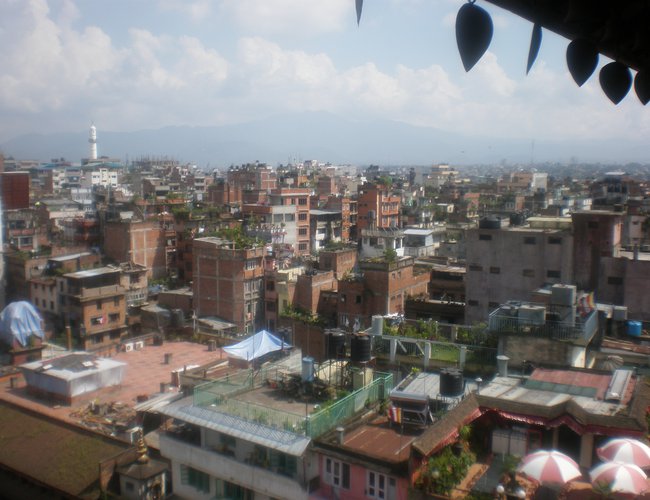
In the reconstruction after the 1890
earthquake a couple of the damaged temples in Bhaktapur Square were pulled down
and not rebuilt. One I believe is being
reconstructed now. Following 2015 many
of the apartment blocks have been patched up and painted anew. Somehow the new shopping malls have not
devastated so much and exist in their glory.
In Japan there is apparently a rule that any building older than 30 years must be torn down and built anew. Is it because they value the lives of their citizens and are averse to earthquake deaths? In spite of this, the shrines and buildings of historical town such as at Kyoto look very old. Were the structures torn down and rebuilt again with the old materials? One wonders.
This brought to my mind an episode of my childhood days. I vaguely picture my father in the sitting room of our house. He had been carried back home to Dillibazar, having falling though the floor of the second storey of the palace of Samar Shumsher at Gyaneshwar. It was said that the wood of the building having been perhaps brought from Hetauda had been eaten through by the termites causing the floor to cave in. My father was lucky, not to have died.
The Rana palaces constructed during the times of Jung Bahadur, Bir Shumsher, Chandra Shumsher and Juddha Shumsher were constructed with the technology prevailing at that time. Not the hard sal wood but sallo, susceptible to termites was used with mud, bajra, chaku etc as the binding material of the bricks instead of cement. Many of the buildings such as the original Bagh Durbar, the Old Naranhity Palace have succumbed to termites and to wear and tear. Some like the Lal Durbar and part of Singha Durbar succumbed to fire. Kirti Babu, who died recently but was PM in 1973, was the man to give the order to blast Singha Durbar and to separate the front bit before the fire consumed it. He resigned soon after. Whilst most of what was destroyed by the fire has been reconstructed as per its former structures, the front part after a great deal of discussion on whether to construct new or retrofit is still in a state of non activity. One has only to look at the deplorable state of the Southern flank of Singha Durbar gate to realise the tendency of Nepali officialdom not to make decisions.
Following the earthquake of 2015 a number of the existing Rana Palaces are said to have incurred substantial damage. Luxmi and Lalita Nivas have already been pulled down and new structures, hopefully somewhat earthquake resistant will come into place. Harihar Bhawan with its library is said to be in shambles and the valuable library books in a terrible state of neglect. How long can this go on?
A deplorable sight exists on the Western flank of the Ranipokhari. This is the Durbar School, built initially at Thapathali for Rana children, transferred here by Dev Shumsher and opened to the public. This relatively small building houses the Durbar High School (now Bhanu Bhakta Madhimik Bidyalaya) and Sanskrit Viddhalaya. Many former illuminati of Nepal have passed through its portals but nothing has been done as yet in its reconstruction. Its reconstruction, like that of the Ranipokhari, is a total fiasco.
Recently there has been in Facebook some posts showing an empty Ranipokhari with the Balgopaleshwar temple in the midst of the emptied out Queen’s Pond as background. Such is the state of affairs two and half years after our devastating earthquake of April 2015 in our very capital. There is even a conjecture that this is being delayed so that perhaps a shopping mall with an underground parking can be built there.
England is the classical example of keeping heritage sites for tourists to come to and admire. Together with Stonehenge they have numerous places and palaces to visit. In Nepal it is the advent of tourism and the wish to bring in dollars that has it prompted our Heritagewallahs to clamour for the retaining the old Rana palaces. The using of mud, chaku and bhush or bajra for that matter whilst ignoring newer materials like cement, is like turning a blind eye to development. The new can be combined with the old as is been exemplified by the new building of what was the old Military Hospital. A frontage replica has been combined with new construction.
Road widening and massive car influx has taken over. At Jawalakhel the earthquake damaged building of Barunyantra has been pulled down but on the railings of the Ugrachandi temple nearby there used to be a notice stating that it can't be pulled down on the pretext of road widening!
It is common knowledge everywhere that tourists come to far off places to see vistas or undergo different experiences. The time has come to think of new tourist sites in the seven provinces of New Nepal. We should not be Kathmandu centric on Rana palaces but rather explore new areas along the East / West axis of this land. There are options of adventure tourism, religious tourism and cultural tourism. There has been adequate publicity about the potentials of Ilam and Karnali, besides other sites.
Lastly I remember the ditty 'Oh the London Bridge is falling down, falling down.....' No wonder then that the British, a 'Nation of Shopkeepers' sold it brick by brick to the Americans who took it to the USA and rebuilt it there! Can we do that with some of the damaged palaces of Kathmandu just like the Gehendra SJB Rana built Dhir gun which has been taken like stolen idols and other artefacts to foreign lands. There may be some US billionaires interested in buying a Rana Durbar from Kathmandu and transporting it there!

Hemang Dixit
The author writes fiction under the name of Mani Dixit. Website: www.hdixit.org.np. Twitter: @manidixithd
- Top Heavy
- Sep 20, 2023
- Most Able?
- Sep 04, 2023
- Changing Times
- Aug 21, 2023
- Nepali Shenanigans
- Aug 03, 2023
- Budget Naataks
- Jun 29, 2023












